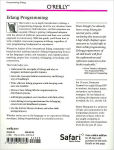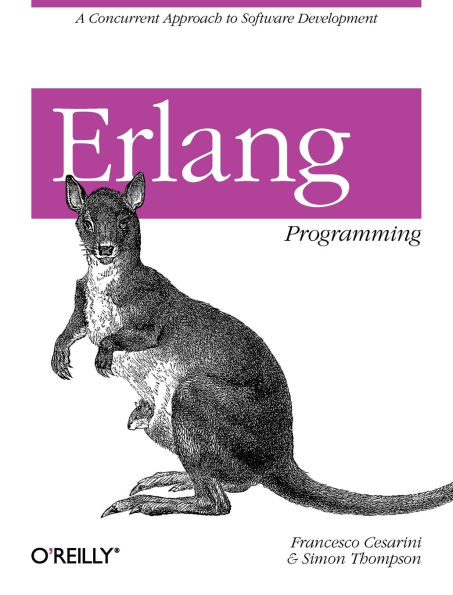Erlang Programming
This book is an in-depth introduction to Erlang, a programming language ideal for any situation where concurrency, fault tolerance, and fast response is essential. Erlang is gaining widespread adoption with the advent of multi-core processors and their new scalable approach to concurrency. With this guide you'll learn how to write complex concurrent programs in Erlang, regardless of your programming background or experience.
Written by leaders of the international Erlang community — and based on their training material — Erlang Programming focuses on the language's syntax and semantics, and explains pattern matching, proper lists, recursion, debugging, networking, and concurrency.
This book helps you:
1100177898
Written by leaders of the international Erlang community — and based on their training material — Erlang Programming focuses on the language's syntax and semantics, and explains pattern matching, proper lists, recursion, debugging, networking, and concurrency.
This book helps you:
- Understand the strengths of Erlang and why its designers included specific features
- Learn the concepts behind concurrency and Erlang's way of handling it
- Write efficient Erlang programs while keeping code neat and readable
- Discover how Erlang fills the requirements for distributed systems
- Add simple graphical user interfaces with little effort
- Learn Erlang's tracing mechanisms for debugging concurrent and distributed systems
- Use the built-in Mnesia database and other table storage features
Erlang Programming provides exercises at the end of each chapter and simple examples throughout the book.
Erlang Programming
This book is an in-depth introduction to Erlang, a programming language ideal for any situation where concurrency, fault tolerance, and fast response is essential. Erlang is gaining widespread adoption with the advent of multi-core processors and their new scalable approach to concurrency. With this guide you'll learn how to write complex concurrent programs in Erlang, regardless of your programming background or experience.
Written by leaders of the international Erlang community — and based on their training material — Erlang Programming focuses on the language's syntax and semantics, and explains pattern matching, proper lists, recursion, debugging, networking, and concurrency.
This book helps you:
Written by leaders of the international Erlang community — and based on their training material — Erlang Programming focuses on the language's syntax and semantics, and explains pattern matching, proper lists, recursion, debugging, networking, and concurrency.
This book helps you:
- Understand the strengths of Erlang and why its designers included specific features
- Learn the concepts behind concurrency and Erlang's way of handling it
- Write efficient Erlang programs while keeping code neat and readable
- Discover how Erlang fills the requirements for distributed systems
- Add simple graphical user interfaces with little effort
- Learn Erlang's tracing mechanisms for debugging concurrent and distributed systems
- Use the built-in Mnesia database and other table storage features
Erlang Programming provides exercises at the end of each chapter and simple examples throughout the book.
49.99
In Stock
5
1

Erlang Programming
470
Erlang Programming
470
49.99
In Stock

Product Details
| ISBN-13: | 9780596518189 |
|---|---|
| Publisher: | O'Reilly Media, Incorporated |
| Publication date: | 06/26/2009 |
| Pages: | 470 |
| Product dimensions: | 7.00(w) x 9.10(h) x 1.10(d) |
About the Author
From the B&N Reads Blog



